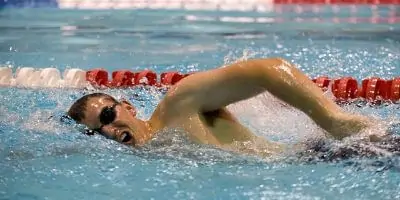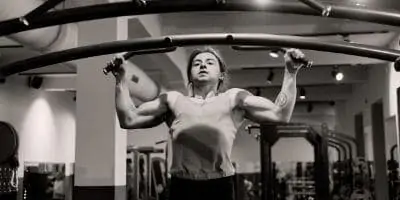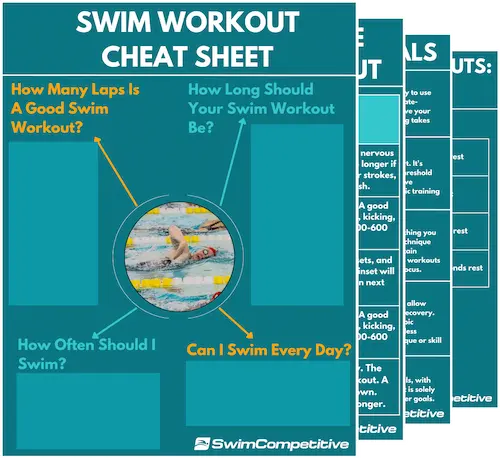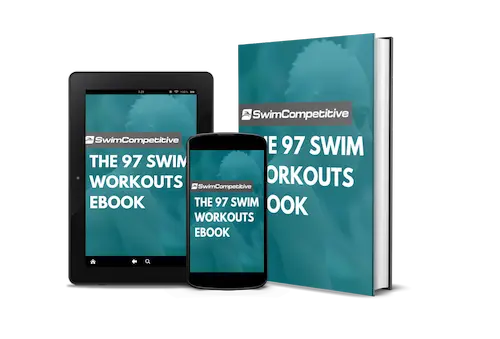If I had to recommend one single exercise to swimmers it would be the pull-up. And that’s why in today’s article we will be looking at why every swimmer should do pull-ups.
Pull-ups are one of the most common and basic exercises out there, yet it is still one of the best and very challenging. It is also one of the best dryland exercises for competitive swimmers to improve their times in the pool.
The pull up is a great exercise to strengthen your back, lats, and shoulders. These muscles play a big role in swimming and strengthening them will help you to swim faster.
The lats and back play an important part in developing a strong pull in your stroke. The pull is a major driver of speed in the water and strengthening your lats will help to build a stronger pull. The pull up develops the lats very well and you could do wide-grip pull-ups to target them further.
Pull-ups can also be a decent core exercise if you make a few small adjustments. For example, once you are able to perform a set of 10 basic pull-ups with decent form, then you can move to strict pull-ups.
You will perform a very controlled pull up with your legs pointed out slightly to activate the core while performing your strict pull-ups.
Overall the pull-up is an excellent exercise for swimmers and I highly recommend that you should add them to your training schedule since it targets and strengthens the majority of the important muscle groups used in swimming. So with that said, let’s take a more in-depth look into the exercise-
Swimming Pull-Ups: 5 Benefits of Pull-Ups for Swimmers
1. Pull-Ups Will Help You Swim Faster (Duh)

The pull up will directly strengthen your back, lat, and shoulder muscles, which are all critical in swimming. If you perform pull-ups over a good period of time, let’s say 3-6 months you will significantly strengthen these important swimming muscle groups.
As mentioned earlier the lats, back, and shoulder muscles all play a very important role in the pulling motion of your stroke.
Thus if you want to increase speed in the water, then you should build a stronger pull and the pull up will assist in doing just that.
By strengthening these muscles you’ll develop a more powerful pull which will allow you not only to swim faster but also to swim for longer periods of time at once.
Apart from developing a stronger pull, the pull-up can also be adjusted in various ways to target the abdominal muscles in your body. The core muscles are very important for staying stable in the water and swimming with excellent technique, which is one of the most important aspects of fast swimming.
One study published by the journal of Strength And Conditioning Research found viable correlations between pull-up strength and swimming performance [1]. The study mainly investigated shorted distances like the 50, but there is no doubt that pull-ups will also be beneficial for longer distance swimmers.
If you want to learn about some more exercises to strengthen your core muscles. Consider checking out my article on the best core exercises for swimmers. By combining pull-ups and core exercises you can create a very simple, yet effective dry-land training routine that you can perform at home in about 30-45 minutes a few times a week.
2. Pull-Ups Are Time Effective
When it comes to back and lat exercises, there is an overwhelming amount of exercises to choose from- dumbbell lateral raises, lat pulldowns, barbell rows, dumbbell rows, inverted rows, chest supported rows, etc. I think you get the idea.
As swimmers, we don’t want to be doing 10 different exercises for each muscle group- we are athletes, not bodybuilders. Our main goal is to swim as fast and efficiently as possible and to achieve this we can’t be spending all day in the gym.
That’s why it is important for us to have a few exercises that will strengthen all the important muscles groups for swimming, but not overload us with volume so that we can still train hard when we are in the water.
The pull-up is the best exercise for that critical lat and upper-back strength [2] and also trains many additional muscles like the shoulder and core which are all required in swimming, and that’s why we should use it as it’ll allow us to effectively strengthen these muscles without doing a bunch of different exercises for each.
3. Pull-Ups Will Improve Posture
Swimmers have a tendency to have bad posture. And living with bad posture increases risk of injury and isn’t the most comfortable thing in the world. By doing pull ups you’ll be working the scapular retractors which will help you to open up your chest and shoulders a bit so that you’ll have improved posture.
This help you to swim with better efficiency, lower your risk of injury, and help you to feel better throughout the day, which is always valued.
4. Pull-Up Technique Is (Relatively) Straightforward to Learn
Unlike many frequently used athletic exercises, like the overhead press, back squat, deadlifts, or bench press, the pull-up is easy to learn since the technique is basic and only has a few cues that you have to focus on.
This helps you to safely perform the exercise, without the risk of getting injured like in many of the exercises mentioned above. You also don’t really have to hire a personal trainer to help you learn good technique, you can learn it on your own or ask a teammate to help you with the basics. (just make sure to warm-up properly).
5. Reduced Risk of Back or Shoulder Injuries
As mentioned, pull-ups target a wide variety of muscle groups with the shoulders, lats, and back being the prime activators. Stronger shoulder and back muscles will be able to endure more resistance and stress than weaker muscles.
And by performing pull-ups you will also train smaller stabilizer muscles in the shoulder which are at risk of injury when not strengthened since swimming has a tendency to overuse these muscles creating a condition know as swimmer’s shoulder.
Thus if you do pull-ups you will strengthen your shoulders and reduce the risk of injury. Shoulder and back injuries are quite common in swimming and I have experienced a few myself. And by dishing out some pull-ups you can both swim faster and lower your chances of getting injured.
Proper Pull-Up Technique for Swimmers
Proper pull-up technique is very important. I know I said it is easy to learn, but doesn’t mean you should neglect it. Performing pull-ups with proper technique will help you get the most out of the exercise and will also ensure that no injuries occur.
Here’s how to do it-
- Grab the pull-up bar with your palms down and facing away from you.
- Arms should be shoulder width-apart or just outside of shoulder-width apart.
- Pull yourself up by pulling your elbows to the floor, focus on keeping your shoulders back and down as you pull.
- Go all the way up until your chin passes the pull-up bar.
- Lower yourself in a controlled manner until your arms are completely straight.
How to Start Doing Pull-Ups: Top 3 Progressions
Like I mentioned earlier the pull up isn’t the easiest exercise out there. However, it certainly isn’t impossible for any normal person to become really good at doing pull-ups.
If you are a complete beginner to pull-ups and you struggle to get 1 or 2 reps then there are some other pull up variations and progressions you can apply until you are strong enough to perform proper pull-ups.
Pull-Up Progression 1
Australian pull-ups- These are very similar to a normal pull up except you are lying at an angle of about 45º with your feet on the ground. Here is a quick video you can watch to on how to do Australian pull-ups with proper form-
Pull-Up Progression 2
Once you can do a couple of Australian pull-ups you can move onto progression 2, that said, you can also use both progressions at once if you are strong enough. The negative pull-up is a highly effective way of learning the proper pull-up and will help you get there in no time if performed consistently.
Watch this quick-video to see how to perform them-
Do You Want to Make Every Lap Count?
Stop wasting your time in the pool feeling lost and doing directionless swim workouts, and start training effectively! Our ebook contains 97 structured and goal-orientated swim workouts to help you become a better, faster, and fitter swimmer. Whether you’re a complete beginner or a seasoned pro, there are a multitude of workouts for every type of swimmer.
Pull-Up Progression 3
Pull-ups with resistance bands- This is pretty simple you just take your resistance bands and put them over your pull up bar, then you place your feet in the resistance bands and do as many pull-ups as you can. Do this until you are strong enough to do normal pull-ups.
This progression can also be used with the other 2 mentioned above, there isn’t really a set rule for which you should use first. Choose 1 or 2 that works for you and stick with it.
If you need some resistance bands, I recommend checking out these ones on Amazon:
Ideal for assisted pull-ups and many other dryland exercises that swimmers can perform.
Why Proper Pull-Up Technique Is Very Important
We have all seen those people who swing around like monkeys until they finally manage to do 10 pull-ups. Yes, while this might work to get the 10 reps it is practically useless. When you do pull ups like this you are simply using momentum to reach the top of the bar and thus it doesn’t really have much of a strength benefit for you as a swimmer.
Focus on performing controlled pull-ups without using momentum. If you require a bit of momentum at the beginning that is fine, but as you get stronger you should aim to reduce momentum and perform a controlled movement.
Also, make sure to completely retract your scapula at the bottom of the pull-up, you should be completely stretched out at the bottom of the movement, don’t do half-reps as this also reduces the effectiveness of the exercise.
As mentioned, bad technique can also cause injuries, which isn’t something we want.
How to Become Stronger in the Pull-Up

You want to always make sure that you are slowly, but surely becoming a bit stronger at your pull-ups. This is very important because if you don’t progress and become stronger you are simply plateauing with your pull-ups.
Luckily progressing isn’t very hard, but it is going to require physical effort. You can become stronger by slightly increasing the number of reps you perform. For example, you might be able to do 10 pull-ups now, so the next time you should try to do 11 and so on.
Or you could increase the number of sets you do. Let’s say you do 3 sets of 8 reps now, then in 2 weeks make it 4 sets of 8 reps.
Lastly, you can increase your strength by adding weight. However, I don’t recommend you do this unless you have become really strong at pull-ups and you are capable of performing multiple sets with proper technique. Once you are able to do about 4 sets of 15 reps in a row, then consider adding weight, but until then just work on your form and increasing those reps.
You can also incorporate more advanced variations of the pull-up like L-Sit pull-ups, which will also highly activate the core muscles while providing you with all of the standard pull-up benefits.
Equipment Required: Pull-up Bar
Okay if you don’t already have a pull-up bar you have 3 options. I highly recommend that you invest in a pull-up bar or find somewhere to do pull-ups because it will definitely pay off.
Option 1- Most Convenient and Reliable
A wall-mounted pull-up bar is probably the best option, in my opinion. It is much more convenient to have nearby than having to drive to a gym on a daily basis just to get some extra pull-ups in.
Wall-mounted pull-up bars are secure and will also allow you to do other exercises as well. Some examples include straight leg raises, hanging knee raises, and muscle ups.
Option 2- Most Useful
Many countries have outdoor bar parks where there are awesome pull-up and dip bars. If you have one near you and can easily access it on a daily basis, I highly recommend you go there and do your pull-ups.
For some people this might not be the most convenient option since they live too far away, don’t have time to go to a bar park or they are insecure, since they might not be able to do a lot of pull-ups.
Option 3- a Simple Solution
The last option is a simple doorway pull up bar. These are also easy to use since you can simply clip them on or off your doorframe. They aren’t as secure as a wall-mounted pull-up bar and can be limiting for taller swimmers, but they will get the job done.
Do Your Pull-Ups, Swimmer!
I highly recommend all swimmers to add pull-ups to there training routine. Try to do a few sets of pull-ups every day or maybe set a goal like 30 pull-ups per day, broken up into multiple sets performed throughout the day.
I truly believe that if you focus on becoming better at pull-ups, it will increase your speed in the water and help you to swim faster. It has definitely helped me, and can do the same for you.
Keep in mind, pull-ups alone won’t make you a good swimmer, there are many things that go into it like your swimming technique and how hard you work in the pool. The key is to work on everything and stay consistent in training.








